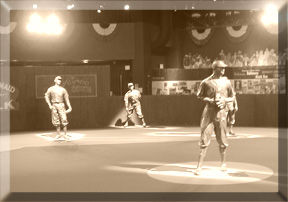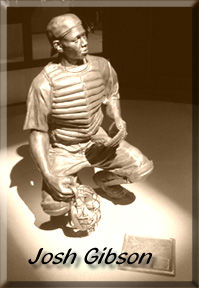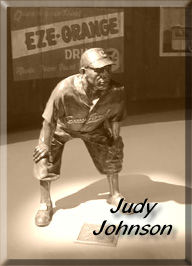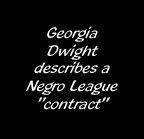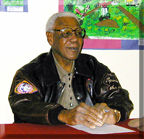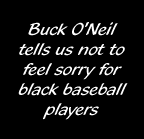
|
Negro Leagues Baseball Museum exhibits
|
The
Pressure to Produce in
the Minor Leagues
"Many
believed, with some justification, that white fans, already discomfited
by the prospect of watching blacks and whites playing interracial baseball,
would have their angst salved only by the opportunity to watch the best
African American athletes available, making the act of purchasing tickets
to integrated games easier to swallow. Countless black ballplayers in
the 1950s faced this same reality. If they did not produce immediately,
they would find themselves released from the team or banished to the
end of the team's bench." "We
needed to see blacks in those stands. They went out of their way to
try to make things comfortable for us. Naturally, we were very appreciative.
They were aware of the things we had to endure, but they were glad we
were out there."
The Negro Leagues Contract
"When
I got to the ballpark for the first game, I couldn't change in the clubhouse.
I had to change clothes at home or in my car. I'd drive to the ballpark
in my uniform. Sometimes, I changed in the hallway outside the clubhouse.
The uniform they first gave me was too big. It was like a 48, but I
had a 31 waist. It was all they had for me..."
Salary in the Negro Leagues "Pay
was also a sore point. The average white big leaguer made $2000 in 1905;
the average minor leaguer, $500, and the average black, $466."
"Salaries varied from individual to individual, and teams differed in
their methods of pay. As might be expected, player paychecks fluctuated
with the economy. During the 1920s, monthly salaries averaged about
$230, but during the Depression-ridden 1930s they fell to about $170....Salaries
paid major leaguers were not public knowledge...based on information
leaked to the press...the average annual salary was probably about $5000
to $6000 in the 1920s and about $7000 in the 1930s." Babe
Ruth received $80,000 in 1930. "Although most Negro leaguers were paid
less than their white counterparts in the major leagues they were much
better off than their black contemporaries outside baseball. Furthermore,
they played twelve months a year, so on an annual basis some made more
than their major leaguer counterparts. The league gave players a chance
for some financial security as well as prestige, respect, and public
esteem." Circa
the depression era - "This is the way I had to
keep from washing windows in a downtown store or sweeping the floors
and these were the kinds of jobs out there for us. So it was better
than washing windows for fifteen dollars a week or twelve dollars a
week That was the average salary in those days."
Training in the Negro Leagues Buck
Leonard of the Grays describes spring training...
"Little teaching took place in [Negro] league camps. Players learned
the finer points of the game by playing. There was no extra work, no
special coaches to work on techniques, and no concern about conditioning.
Such things were considered lavish and strictly for white clubs with
money. The only question anyone asked was could the man play."
A
Negro League On
the base paths in the Negro Leagues... "When you
got on first it was pretty rough going. Infielders would come down on
your legs, spike the base runner. You had to duck those throws on double
plays, you had to duck the ball. They'd throw it at you. You needed
hats like they got now at that time. All the infielders wore shin guards
like a catcher-- and they needed them. " "A
Negro League runner never slid on his stomach, hands reaching for the
bag; that was an open invitation for a spiking by a defensive payer
covering the bag. Instead runners always slid with their spikes up."
"As
might be expected, such aggressiveness led to fights. One of the biggest
rumbles in league history was between the Monarchs and the Chicago American
Giants....League officials understandably tried to minimize such fights,
not only for the integrity of the black game but for the hope of eventual
integration as well...The game was just that heated. The manager didn't
want you out there if you didn't have some fight in you. You'd fight
your own teammate if they were loafing."
|
||||||||||||
